Don't wanna be here? Send us removal request.
Text
Constructing your memory palace with your talent
https://www.youtube.com/watch?v=kT-jOCo6ojs
I want to share this video with every learner. It introduces mnemonics that are systematic procedures for improving memory (Atkinson et al., 1999; Levin, 1994; Rummel, Levin, & Woodward, 2003). My suggestion is to try some of them and find which one works best for you. Actually, I didn’t find any long-term effective one for me, but I can apply one of them in a certain situation. For example, if I have enough time and less pressure, I will use some interesting way, like drawing, playing scrabble game. If my time is limited, such as preparing for the test, I prefer to using rote memorization. I hope the above will be helpful to you. In the end, I sincerely invite you to share your different memory experiences with us.
0 notes
Text
Giving a fantastic context for memory
I am always dreaming I can memorize all the thing I needed in ONE night. So I began to put the learning book under my pillow when I was sleeping a long time ago. But nothing happened. I also try different ways to help my memory. As Li Zhao taught in her book Study Vocabularies by Funny Ways, published in 2010, I can memorize new English words into a fantastic story in Chinese to help me remember these words quickly.
I think this way combines schemas with flashbulb memory to help me remember. Schemas frame a wide range of abstract information together. A schema can guide people’s perception and help people make sense of their experience based on already known (Sternberg & Sternberg, 2012). In this way, I can make full use of the long-term memory that already exists in the brain, like information (which is written in Chinese) related to new information (which is written in English) and mental resources including attention, reasoning and comprehension (Baddeley, 2007; Baddeley, Hitch, & Allen, 2009; Jarrold, Tam, Baddeley, & Harvey, 2011). On the other hand, the story creates a dramatic or emotional scene including new information in the brain. This kind of memory is named flashbulb memory. The brain records the scene with details, like storing a picture. So I can memorize the new information faster and lasts longer.
0 notes
Text
How are these meaningless lyrics remembered happily?
我爱我的幼儿园,幼儿园里活又活......
I love my kindergarten. It’s living again living ......
My 3-year old son sang his song happily after he was back home. But what’s he sing? living again living? I came to him with a big smile and told him he sang a very beautiful song. Then I asked him what the song was about. He told me the teacher taught them this song today and he sang it again. I still heard the strange lyrics! I stopped asking him and began to search the first sentence from the Internet. Then I got the right one, I love my kindergarten. There are lots of friends...... (我爱我的幼儿园,幼儿园里朋友多......)
In this situation, the kid seemed to understand the first sentence, but totally lost in the second sentence. According to his emotion when he sang at home, I guessed that when he was learning the song in the kindergarten, he must had been very excited. I think the kid’s memory of all the information owe to his episodic memory that is related to a specific location and time in one’s life. He just began his kindergarten life for several days and this is the first song he learned from the teacher with his friends. Usually, kids struggle at the beginning of kindergarten life. But this time he enjoyed and even showed what he learned unconsciously at home. Although part of the lyrics is non-sense, he remembered them quickly and got happiness.
0 notes
Text
Memorizing in cognitivism: working memory
When I embarked my studying abroad, I started a terrible journey. In the beginning, I couldn’t read and think at the same time as I used to read Chinese articles. For example, as I read one English academic article the first time, I just looked up all the new words (it usually took me lots of time). Then I read it the second time and just grasped the main contents of the article. In the third time reading, I began to understand the logical relationships of the article and I needed to write them on paper in Chinese. And now I could begin my own thinking. Obviously, if I need to communicate with my teacher or classmates about the article, I must translate my thoughts into English. So I had worked like an obsolete computer for a long time. I struggled every day. What do you think of my terrible reading experience?
For cognitivists, my own thinking of the article can be considered as cognitive load which means the working memory required to complete my thinking. According to van Gog, Pass, & Sweller’s theory, there are three kinds of cognitive load (2010). My own thinking of the article belongs to germane cognitive load, deep processing of information related to the task. If I want to get my own thinking, I need to process all the information from the article and pick up intrinsic cognitive load, the resources required by the task. But language became an obstacle to this process. Before my understanding the article, I couldn’t decide which information should be extracted as intrinsic cognitive load. It took me a lot of time to eliminate all the new words and understand the whole article. However, the good thing is the time spent learning words and understanding the meaning of the article has become shorter and shorter.
0 notes
Text
Recitation is more than behaviorism
滴答,滴答,下雨了。
种子说:“下吧,下吧,我要发芽。”
小草说:“下吧,下吧,我要长大。”
小树说:“下吧,下吧,我要开花。”
小朋友说:“下吧,下吧,我要种瓜。”
滴答,滴答,下雨了。
Translation
Tick, tick, it’s raining.
The seed said, “Raining, raining, I want to germinate.”
The grass said, “Raining, raining, I want to grow up.”
The tree said, “Raining, raining, I want to blossom.”
The child said, “Raining, raining, I want to grow melons.”
Tick, tick, it’s raining.
Reciting this children’s poem was my son’s homework when he was in primary school grade one. The teacher has taught him how to read the poem. After school, he needed to memorize it. I didn’t think this assignment was difficult. I left himself in his room for remembering. However, when I came back to his room half an hour later, he looked at me with tears in eyes and said he just couldn’t recite. What a simple poem! He surprised me. After a while, I figured out how to help him. I began to draw a picture, as you see below. As my drawing, I read and recited the sentence from the poem in the order of the poem and he saw my drawing and repeated with me. When I finished drawing the picture, he almost finished his recitation. Gradually, he could recite the poem by seeing this picture, then without the picture.
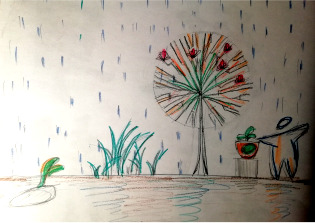
In this case, I believed the kid just needs to read and read again in the beginning. This learning belongs to behaviorism learning theory obviously. But I ignored this might be the first time he got the reciting assignment. Although he has memorized something unconsciously before, he didn’t know how to finish this homework. That is to say, he has experienced how to memorize something but he has no consciousness of these memorizing processes. The case can be interpreted by Albert Bandura’s observational learning which means learning by observation and imitation of others. But traditional behaviorists believe that learning the consequence leads to strengthen or weaken the behavior, while in the observation there is no strengthening or weakening. The consequence offers feedback and generates the expectation of what if the kid imitates me. Bandura posed this theory in his early book, Social Learning Theory (1977). After the kid’s observing my behavior and generating his expectation, he imitated me. Then, he succeeded.
0 notes
Text
The collection, Supplement and Utilization of Water Resources in Beijing
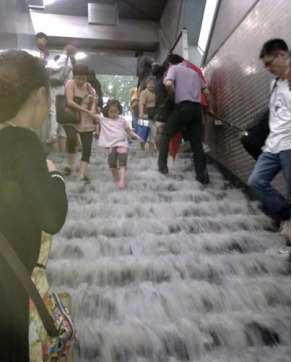
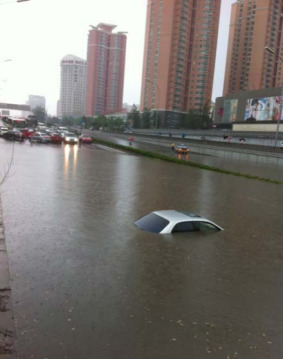
picture 1: Rainwater was pouring back at the entrance of Taoranting Subway Station.
picture 2: At that time, the water under the Lianhua Bridge was 1.2 meters, and the water level was still rising.
The two pictures come from the Internet's report on the rainstorm in Beijing around 4:30 p.m. on June 23, 2011. http://media.sohu.com/20110626/n280724833_3.shtml
Beijing is a water-scarce city, with an average annual precipitation of 500-700 millimeters. But since 2011, there was news of storms flooded the city in June or July every year. In an article entitled "Why is Beijing always flooded by rainstorms? Responsibility is not entirely sewer" In the network article, the author, named Kunmu Yan, points out the problems of Beijing's urban drainage system, such as small drainage pipe diameter, pipeline blockage, original river landfill or being changed into underground, more than 80% of urban pavement is hardened impervious pavement, etc. On one hand, the existing municipal drainage system of Beijing need to be repaired and cleaned up. On the other hand, as urban designers or architects, we face the serious problem that is how to reduce the impact of rainstorms on cities and how to gradually restore the urban ecology that we have destroyed.
So the sustainable design of urban water system has become the focus of many designers.
What can be done for designers?
Permeating of rainwater
Improve urban road design, such as the replacement of rigid impervious pavement as permeable material instead of the original, grassland elevation being equal to or lower than the rigid road elevation in order to let the rainwater from the road flow into the meadow to supplement underground water.

The permeable material in the road.
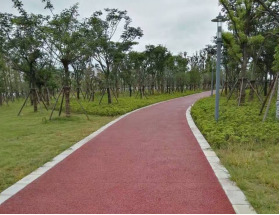
Grassland elevation is equal to path’s
In addition, the parking lots can use grass-tiled floors to increase rain penetration.
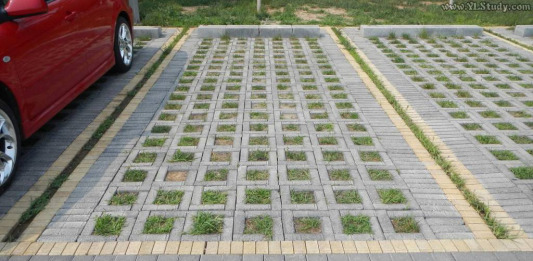
Retention of rainwater
We need a greening system like roof greening, road greening, concentrated landscape greening, and the road rain infiltration. This way can slow down the arrival time of peak value and effectively reduce the amount of rainwater gathering into pipelines to decrease or avoid the losses.
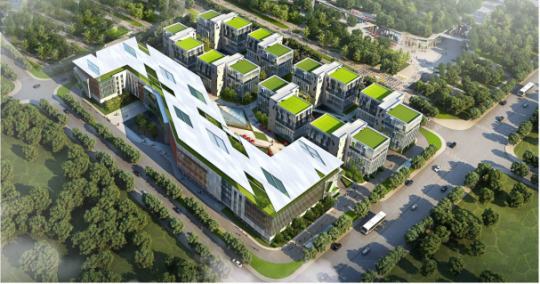
The picture is a bird's-eye view of the design of an office base in Beijing. All the roofs in the picture are designed for roof greening. Rainwater is absorbed and infiltrated by the roof greening before water flowing into the drainage system, which prolongs the time of rainwater collection and reduces the flow value during the peak period.
Storage, purification, and reuse of rainwater
The water collected from the road or greening of the site can be stored in the underground storage tank or enter the urban rainwater collection system. After the filtration of vegetation and the treatment of rainwater purification equipment, the collected water can be used for plant irrigation, firefighting, landscape pool water, car washing, road washing, toilet flushing, etc



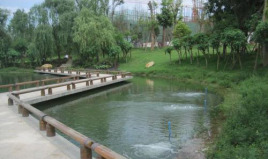
In summary, Beijing as a water-scarce city with a population of 20 million, the water system design needs to collect, replenish and use water resources reasonably to improve the city's ecological environment to meet the needs of sustainable development.
1 note
·
View note
Text
Reflection
I was a little bit depressed when I wrote this reflection. Through the two week's notes and reflections, I found some unreasonable eating habits in my family and I couldn’t change it right now.
The first thing is fish and surplus. Mom is a person who is influenced seriously by the old Chinese tradition in some ways. She firmly believes that some allegorical meaning can bring us a rich and beautiful life, such as fish and surplus. In Chinese, the pronunciation of surplus and fish are the same, so when we start our new life in Canada, she is very eager to do two things to show the meaning of surplus, which means we have had a good beginning. The first thing is to cook a complete fish to eat during holidays or weekends, to symbolize wealth in all aspects. Secondly, whether we cook at home or eat out, there must be a surplus for the food, which also is a symbol of affluence. In order to meet my mom’s two demands for food, I had to go to various supermarkets to look for the whole fish to buy for her, but I was not familiar with the fish here, and she was often dissatisfied with the fish I bought because the taste of the fish is very different from her expectation. This often makes her very unhappy. In order to meet my mom’s second requirement, I have to buy more things when I go to the supermarket shopping for every week and I also have to prepare one or two extra serving for every meal. In fact, the superfluous food I bought is often left at home for more than a week without being eaten or even rotten. The extra portion of each meal often gets thrown away when we cannot finish so much food at the next meal. When I suggested that I wanted to eliminate this waste which looks just for good luck or my mom’s satisfaction with a diet, my mother would define me directly as unfilial. By the way, filial piety is considered one of the most important Chinese traditional virtues. If my mother always said my unfilial things to relatives, that will put a lot of pressure on me. So I had to follow her demands on the diet. The things that I can do are I will not discard something that can be reused and I will choose healthy ingredients, try to cook in a healthy way, and make traditional Chinese food several times a week to meet the needs of my mother, which is also considered the continuation of traditional Chinese food culture at home.
Luckily, my mother finally agreed this week that she would back to Beijing at the end of this year's Christmas holiday. So I could adjust my consumption in a green and sustainable direction. I never want to refuse to keep the traditional culture, but I think the maintenance of the traditional culture in the new environment also needs to make appropriate changes to adapt to the new context.
Two weeks consumption (10.29-11.11)

Family weekly food shopping 1:
(family members including my mom, my son and I)
Time: Every Friday evening
Place: Costco
Things: Food
Cost: about 200$
Family weekly food shopping 2:
(family members including my mom, my son and I)
Time: Every Saturday morning
Place: Maxi or Super C
Things: Food
Cost: 80-100$

Halloween shopping 1:
Time: Oct.30 morning
Place: Walmart
Things: Costume for children (reusable)
Cost: 48.54$
Halloween shopping 2:
Time: Oct.31 evening
Place: Costco
Things: A box of candy (gift), a silly storybook for children in French (for
learning), a box of dessert (6 cups will be reused)
Cost: 43.21$

Measures:
Weekly food shopping includes fruit, vegetables, meat, and seafood.
Replace sugary juice to vegetable seafood soup.
Make healthy Chinese traditional food sometimes.
Consider the reuse of something.
2 notes
·
View notes
Text
Culture sustainability in the campus of Bishop’s University
When our group finished the discussion of designing a course plan of using systems thinking to teach some sustainable development concepts and walked out of the library at noon on this Friday, I was fascinated by the scenery of the Court on our campus in the sunshine. I couldn’t help but go around the campus and the term “culture sustainability” kept recurring in my mind. This forced me to reconsider whether I would like to change the topic of my blog homework, a long way of the application of ground source heat pump system in a building, that I have nearly finished.
What triggered the idea of my changing the topic to culture sustainability in our campus? I think the clues which hide in this wonderful scenery give me inspiration. I guess one of the most intuitive clues is an architectural symbol’s evolution in buildings’ facades.
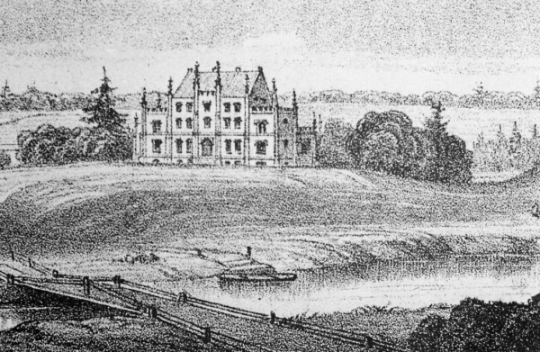
Figure 1 (Mountain,1846)
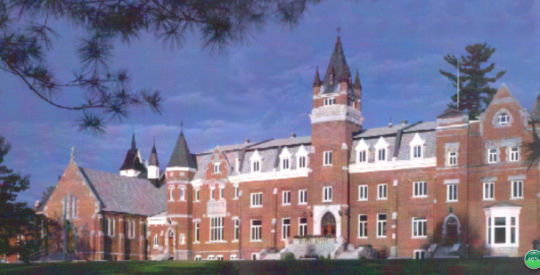
Figure 2
Mountain (1846) collected this picture (see Figure 1) in his book. It is a picture of Bishop’s University’s first building which was built in 1846 (Mountain, 1846). Although the building had been destroyed partly in a fire in 1876, the existing buildings still bear some resemblance to it (see Figure 2). The style of the first building’s facade is mainly British Romantic Architecture (Duggett, 2010) because of the background at that time. After the middle ages in Europe, the Renaissance liberated humanity from the 14th to 17th centuries. In the early stage of the Industrial Revolution, people did not have the aesthetics of the industrial age, so the romanticism of reviving Gothic style appeared in Britain. Just in this period, Bishop’s first building was built in romantic style on campus. As we can see from the first building’s picture, British Romanticism emphasizes vertical lines while spreading out horizontally. The point is the buttress used to express the vertical lines has transformed from the original structural component, which could counter the outward thrust from the rib vaults of the nave, into a decorative component. Moreover, we still can find these decorations in buildings’ facades on campus nowadays, but the decorations have been greatly simplified in later designs.
In the following two pictures (see Figure 3&4), the buttresses do not even reach the roof, so they can not bear the direct force of the roof. Furthermore, the roof of the building in the picture is no longer an arch structure and does not need to resist horizontal lateral thrust. However, in the era of designing this building, people might want to show their respect to the traditions, or they might want to express their faith through these decorative columns wall pillars, or they might use these decorations to better reflect people's joy after the liberation of human nature because these decorative columns can bring people a cheerful atmosphere. As architecture takes a long time to exist, it has been expressed in their own symbolic language since the day of its birth. So we can find the footprints of culture from their facades. They expressed the past and now.
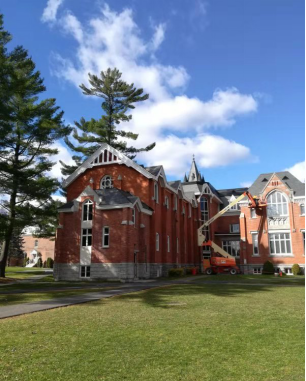
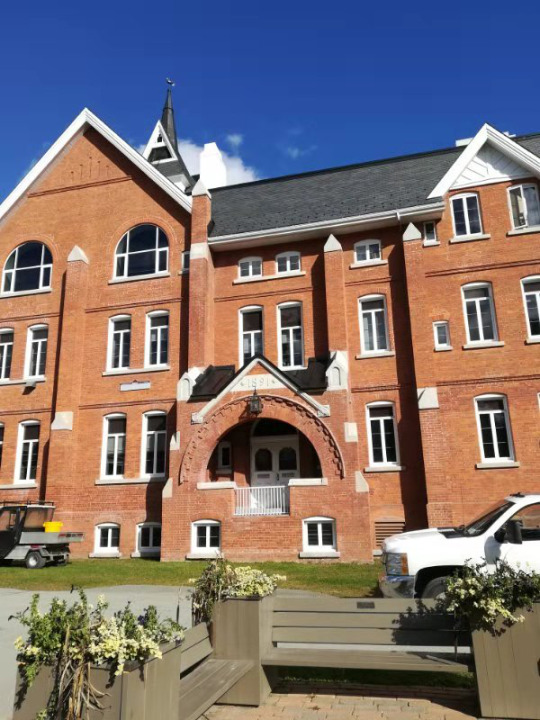
Figure 3&4
Then, how about the future? The new library can explain to us about the future. The following pictures are the library and the court (see Figure 5, Figure 6 & Figure 7). The library is a modern building with concise exterior wall and windows, without a redundant adornment, which designed in the present context. Although it was built this year, you will feel like the buildings around you are completely uniform when you are standing in the middle of the court looking around. The current architect expresses the same morals, values, and culture in his own way and meets the needs of the functions at the same time. So culture can be sustained.
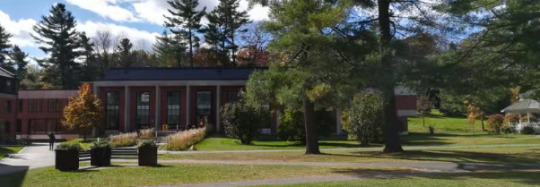
Figure 5
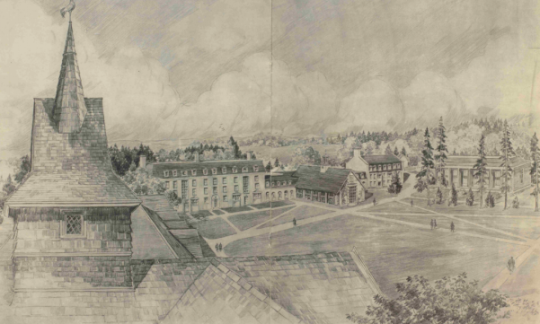
Figure 6

Figure 7
In summary, culture sustainability means, on one hand, the culture has passed through a long history, is still alive, and is able to adapt to the context in the future, on the other hand, during the procedure of development, the culture’s eliminating its dross and taking its essence to fit the context is more conducive to socially sustainable development. In addition, architecture has a long service life so we can find the footprint of cultural development in the environment and the new generation will develop the culture after their analysis.
Concepts:
Culture is described as following in the (a) the customary beliefs, social forms, and material traits of a racial, religious, or social group also the characteristic features of everyday existence shared by people in a place or time (b) the set of shared attitudes, values, goals, and practices that characterizes an institution or organization ... (d) the integrated pattern of human knowledge, belief, and behavior that depends upon the capacity for learning and transmitting knowledge to succeeding generations. (Merriam-Webster, n.d.)
Sustainability is the capability of being sustained. (Merriam-Webster, n.d.)
References
Culture. (n. d.) In Merriam-Webster dictionary. Retrieved from https://www.merriam-webster.com/dictionary/culture
Duggett, T. (2010). Gothic Romanticism: Architecture, Politics, and Literary Form. New York: PALGRAVE MACMILLAN
Figure 2. Chronology of Bishop’s University buildings. Retrieved from http://www3.ubishops.ca/?id=1663
Figure 6. (1963, January 14). The Illustrated London News. 54-55. Retrieved from http://www3.ubishops.ca/fileadmin/bishops_documents/library/images/timeline/BUC-10 9_Illustrated_London_News.pdf
Figure 7. Campus tours and events. Retrieved from https://www.ubishops.ca/future-current-students/campus-tours-events/
Mountain, G. J. (Collector). (1846). Songs of the Wilderness, Being a Collection of Poems. Retrieved from http://www3.ubishops.ca/?id=1663
Sustainability. (n. d.) In Merriam-Webster dictionary. Retrieved from
https://www.merriam-webster.com/dictionary/sustainability
2 notes
·
View notes